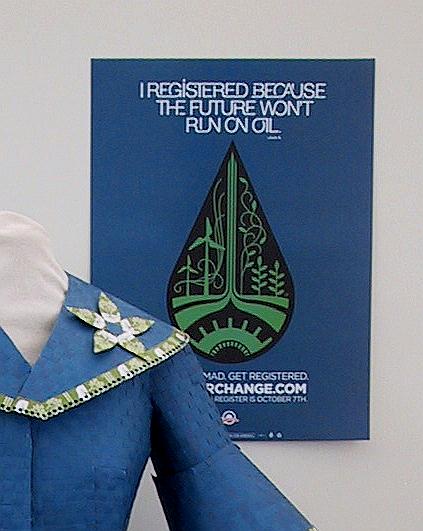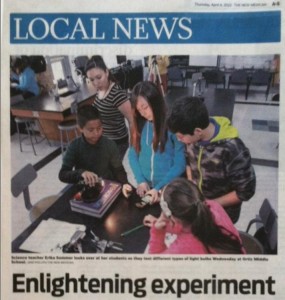Ortiz students test bulbs, make ‘trash fashion’ to learn about conserving
Read the article and see photos on line.
In an effort to draw attention to energy conservation efforts, Ortiz Middle School students engaged in a battle of the light bulbs in science class Wednesday, while building an “Energizer” superhero costume.
Their efforts were part of a collaboration between Santa Fe Public Schools, Recycle Runway artist Nancy Judd, Public Service Company of New Mexico and the Santa Fe Community College. The program, funded by a Toyota Together Green Grant and the National Audubon Society, was manpowered by about 125 sixth-graders at Ortiz.
The project is evenly divided between an experiment into how energy is created and conserved in Erika Sommer’s science class and an art-and-design “trash fashion” project in teacher Myoko Costello’s home-economics class.
Judd, an environmental activist and artist who runs Recycle Runway (creating “couture attire” from recycled items), said the project’s goal is to instill a sense of energy conservatism in the kids, with the hope that they will take what they learned home and incorporate their lessons into their home life. Lisa Randall, the school district’s energy conservation coordinator, said it provides “a home-school connection to energy conservation” that one doesn’t usually find in lesson plans.
Sommer’s class was engaged in an experiment to compare whether a 40-watt incandescent light bulb or a compact fluorescent light bulb (CFL) generates more light — and which one uses the most energy.
The students had to measure the amps, the lumens (a measure of the amount of light a bulb produces) and the watts of each bulb via a not-too-complicated setup involving a bulb board, a light meter and an interactive computer screen.
At one table in the class, several students, including Daryl Herrera, compared the effects of the two bulbs and came to the conclusion that the CFL bulb used less than half the energy of an incandescent bulb. (Most studies indicate that CFL bulbs use 75 percent less energy and last 10 times longer than an incandescent bulb.) Herrera said he found the experiment useful, “So we know which bulbs we should use at home.”
Following the class, the kids were asked how many believed the project would make them want to conserve energy at home. Almost all raised their hands. Asked how many would suggest to their parents that the latter use CFL bulbs, almost all raised their hands again. And when asked how many of them have parents who actually listen to them — well, only about a third raised their hands.
Down the hallway, Judd organized the art students into teams to build the parts needed for the Energizer costume, which is due to be completed by the end of April. Afterward, the costume — currently sans a superhero to wear it — will tour the schools and perhaps other sites within the city.
To ensure it really is an energy-efficient costume, Judd utilized everything from HVAC duct vents (for the arms), a high-efficiency heater flue, PCP pipe, window insulation and discarded 2008 Obama campaign signs. Why Obama? “That’s mostly what can be found in Santa Fe,” Judd replied.
One of the art students, Rudi Martinez, busied herself making small solar panels to line the Energizer costume’s 60-inch by 45-inch cape. “We need to learn how to save energy rather than waste energy,” she said as she worked.
Ryan Baca, who was on hand to represent PNM, which provided all the kids with home energy kits (including CFL bulbs), seconded that thought. She said kids today have a greater awareness about environmental needs and conservation efforts and that this joint project gives them “a good, solid foundation in what energy conservation means to their community, their school and their home.”
Next week, Santa Fe school buildings will be placed in a “sleep mode” for spring break. Lights and computers will be shut off and heating kept to a minimum.









































